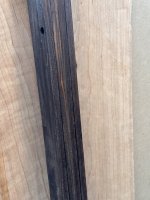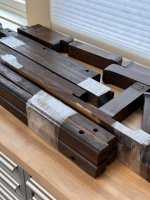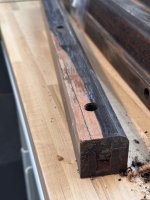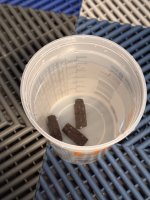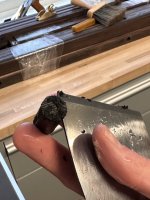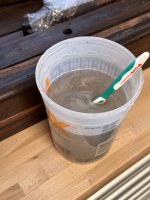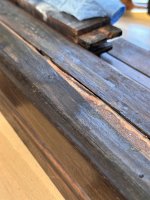aCircle
Member
- Joined
- Nov 24, 2020
- Messages
- 45
Hey FOG -- hoping you all can help me with a spot of wood identification.
My grandparents were in the Foreign Service and had some furniture made when they were posted in Indonesia in the early 1950s. That furniture has since taken a beating (grandfather was hard on his things, then in my parent's basement for ~20 years) and I now find myself with this lumber of unknown species.
I've got a few clues:
// It's heavy. Like, really, really heavy. I can't remember ever personally handling lumber this dense.
// There doesn't appear to be any sort of finish, so this color and mottling seems to be natural.
// It's quite brittle. Trying to plane down a tiny bit got me a whole bunch of tear-out, so I stopped.
// My dad seems to remember it being some sort of old-growth hardwood. If that's the case then it's probably illegal to cut whatever it is now.
I'm wondering what you all think this might be. If we figure out what it is, I'd love some advice on how to work with it! Most of my experience to date has been with domestic hardwoods so exotics is a new one for me.
My grandparents were in the Foreign Service and had some furniture made when they were posted in Indonesia in the early 1950s. That furniture has since taken a beating (grandfather was hard on his things, then in my parent's basement for ~20 years) and I now find myself with this lumber of unknown species.
I've got a few clues:
// It's heavy. Like, really, really heavy. I can't remember ever personally handling lumber this dense.
// There doesn't appear to be any sort of finish, so this color and mottling seems to be natural.
// It's quite brittle. Trying to plane down a tiny bit got me a whole bunch of tear-out, so I stopped.
// My dad seems to remember it being some sort of old-growth hardwood. If that's the case then it's probably illegal to cut whatever it is now.
I'm wondering what you all think this might be. If we figure out what it is, I'd love some advice on how to work with it! Most of my experience to date has been with domestic hardwoods so exotics is a new one for me.

